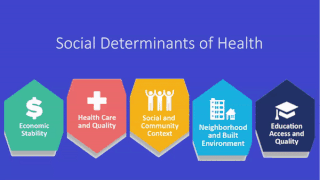Related Research Articles
Health equity arises from access to the social determinants of health, specifically from wealth, power and prestige. Individuals who have consistently been deprived of these three determinants are significantly disadvantaged from health inequities, and face worse health outcomes than those who are able to access certain resources. It is not equity to simply provide every individual with the same resources; that would be equality. In order to achieve health equity, resources must be allocated based on an individual need-based principle.

Population health has been defined as "the health outcomes of a group of individuals, including the distribution of such outcomes within the group". It is an approach to health that aims to improve the health of an entire human population. It has been described as consisting of three components. These are "health outcomes, patterns of health determinants, and policies and interventions".
Covert racism is a form of racial discrimination that is disguised and subtle, rather than public or obvious. Concealed in the fabric of society, covert racism discriminates against individuals through often evasive or seemingly passive methods. Covert, racially biased decisions are often hidden or rationalized with an explanation that society is more willing to accept. These racial biases cause a variety of problems that work to empower the suppressors while diminishing the rights and powers of the oppressed. Covert racism often works subliminally, and often much of the discrimination is being done subconsciously. Sometimes, it originates instead in discrimination against poorer segments that simply happens to disproportionately affect individuals by race.

The social determinants of health (SDOH) are the economic and social conditions that influence individual and group differences in health status. They are the health promoting factors found in one's living and working conditions, rather than individual risk factors that influence the risk for a disease, or vulnerability to disease or injury. The distributions of social determinants are often shaped by public policies that reflect prevailing political ideologies of the area. The World Health Organization says, "This unequal distribution of health-damaging experiences is not in any sense a 'natural' phenomenon but is the result of a toxic combination of poor social policies, unfair economic arrangements [where the already well-off and healthy become even richer and the poor who are already more likely to be ill become even poorer], and bad politics."
Race and health refers to how being identified with a specific race influences health. Race is a complex concept that has changed across chronological eras and depends on both self-identification and social recognition. In the study of race and health, scientists organize people in racial categories depending on different factors such as: phenotype, ancestry, social identity, genetic makeup and lived experience. “Race” and ethnicity often remain undifferentiated in health research.

The University of Pittsburgh School of Social Work, one of the 13 schools and colleges within the University of Pittsburgh, is located in the Oakland section of Pittsburgh, Pennsylvania. Its offices are in the world-famous Cathedral of Learning, a forty-story, Gothic style edifice that is the signature building of the university.
Research shows many health disparities among different racial and ethnic groups in the United States. Different outcomes in mental and physical health exist between all census-recognized racial groups, but these differences stem from different historical and current factors, including genetics, socioeconomic factors, and racism. Research has demonstrated that numerous health care professionals show implicit bias in the way that they treat patients. Certain diseases have a higher prevalence among specific racial groups, and life expectancy also varies across groups.
Racial inequality in the United States identifies the social inequality and advantages and disparities that affect different races within the United States. These can also be seen as a result of historic oppression, inequality of inheritance, or racism and prejudice, especially against minority groups.
Structural inequality occurs when the fabric of organizations, institutions, governments or social networks contains an embedded bias which provides advantages for some members and marginalizes or produces disadvantages for other members. This can involve property rights, status, or unequal access to health care, housing, education and other physical or financial resources or opportunities. Structural inequality is believed to be an embedded part of the culture of the United States due to the history of slavery and the subsequent suppression of equal civil rights of minority races.

William A. Darity Jr. is an American economist and researcher. Darity's research spans economic history, development economics, and monetary theory, but the bulk of his research is devoted to inequality in the context of race. In particular, for his 2005 paper in the Journal of Economics and Finance, Darity is known as the 'founder of stratification economics.' His varied research interests have also included the African diaspora, the economics of black reparations, group-based post traumatic stress disorder, and social and economic policy as they relate to race and ethnicity. For the latter, he has been described as "perhaps the country’s leading scholar on the economics of racial inequality."
Societal racism is the formalization of a set of institutional, historical, cultural, and interpersonal practices within a society that places one or more social or ethnic groups in a better position to succeed and disadvantages other groups so that disparities develop between the groups over a period of time. Societal racism has also been called structural racism, because, according to Carl E. James, society is structured in a way that excludes substantial numbers of people from minority backgrounds from taking part in social institutions. Societal racism is sometimes referred to as systemic racism as well.
Thomas A. LaVeist, Ph.D. is dean and Weatherhead Presidential Chair at the School of Public Health and Tropical Medicine at Tulane University in New Orleans, LA. Before joining Tulane he was chairman of the Department of Health Policy and Management at the George Washington University, Milken Institute School of Public Health. LaVeist focuses mainly on the development of policy and interventions to address race disparities in health-related outcomes.
Mental health inequality refers to the differences in the quality, access, and health care different communities and populations receive for mental health services. Globally, the World Health Organization estimates that 350 million people are affected with depressive disorders. Mental health can be defined as an individual's well-being and/or the absence of clinically defined mental illness. Inequalities that can occur in mental healthcare may include mental health status, access to and quality of care, and mental health outcomes, which may differ across populations of different race, ethnicity, sexual orientation, sex, gender, socioeconomic statuses, education level, and geographic location. Social determinants of health that can influence an individual's susceptibility to developing mental disorders and illnesses include, but are not limited to, economic status, education level, demographics, geographic location and genetics.
The weathering hypothesis was proposed to account for early health deterioration as a result of cumulative exposure to experiences of social, economic and political adversity. It is well documented that minority groups and marginalized communities suffer from poorer health outcomes. This may be due to a multitude of stressors including prejudice, social alienation, institutional bias, political oppression, economic exclusion and racial discrimination. The weathering hypothesis proposes that the cumulative burden of these stressors as individuals age is "weathering," and the increased weathering experienced by minority groups compared to others can account for differences in health outcomes. In recent years, the biological plausibility of the weathering hypothesis has been investigated in studies evaluating the physiological effects of social, environmental and political stressors among marginalized communities. This has led to more widespread use of the weathering hypothesis as a framework for explaining health disparities on the basis of differential exposure to racially based stressors. Researchers have also identified patterns connecting weathering to biological phenomena associated with stress and aging, such as allostatic load, epigenetics, and telomere shortening.
John Mckee Wallace, Jr. is an American sociologist who is the David E. Epperson Chair and Professor, Center on Race and Social Problems at the University of Pittsburgh. He also serves as Vice Provost for Faculty Diversity at the University of Pittsburgh.

The COVID-19 pandemic has revealed race-based health care disparities in many countries, including the United States, United Kingdom, Norway, Sweden, Canada, and Singapore. These disparities are believed to originate from structural racism in these countries which pre-dates the pandemic; a commentary in The BMJ noted that "ethnoracialised differences in health outcomes have become the new normal across the world" as a result of ethnic and racial disparities in COVID-19 healthcare, determined by social factors. Data from the United States and elsewhere shows that minorities, especially black people, have been infected and killed at a disproportionate rate to white people.
The COVID-19 pandemic has had an unequal impact on different racial and ethnic groups in the United States, resulting in new disparities of health outcomes as well as exacerbating existing health and economic disparities.
White Americans, as the majority and comparatively advantaged racial group in the United States, have historically had better health outcomes than other oppressed racial groups in America. However, in recent years, the scholarly discourse has switched from recognition of the immense positive health outcomes of White Americans towards understanding the growing persistence of negative outcomes unique to this racial group. Scholars have discussed the effects of racial prejudice and its negative effect on health outcomes to not only those being oppressed but also those being given privileges. In addition to the effects of living in a racialized society, White Americans have the highest rate of suicide and lifetime psychiatric disorders of any other ethnicity or racial category. In conjunction with these psychiatric issues, the population presents higher rates of alcohol usage alongside lower levels of psychological flourishing. In this context, flourishing is defined as a positive mental state associated with no mental disorders and high levels of psychological well-being. Given this information, the health status of White Americans has gained increasing importance due to the differences in health outcomes between White Americans and White people from other parts of the world.

Shannon N. Zenk is an American nurse scientist specialized in researching social inequities and health disparities. She is director of the National Institute of Nursing Research.
Valerie Rawlston Wilson is an American economist who directs the Economic Policy Institute’s Program on Race, Ethnicity, and the Economy (PREE). She was previously vice president of research at the National Urban League Washington Bureau. She researches and writes about economic inequality in the United States in employment and training, income and wealth disparities, access to higher education, and social insurance. She has testified before the United States Congressional Committee on Education and Labor on How COVID-19 Widened Racial Inequities in Education, Health, and the Workforce. She is the 2022 president of the National Economic Association.
References
- ↑ "Center on Race & Social Problems: About the Center". University of Pittsburgh School of Social Work. 2011-11-29. Retrieved 2012-08-14.
- ↑ "Center on Race and Social Problems: Speaker Series" (http://www.crsp.pitt.edu/community-service/speaker-series Archived 2015-03-07 at the Wayback Machine ). Retrieved 2013-12-19
- 1 2 Center on Race and Social Problems. (2012). Annual Report 2011-12 and 10th Anniversary Report. Pittsburgh, PA.
- ↑ "First Race, Ethnicity, and Poverty Summit Held at the University of Pittsburgh Center on Race and Social Problems" (http://www.crsp.pitt.edu/service/reap Archived 2015-03-07 at the Wayback Machine ) Center on Race and Social Problems retrieved 2013-12-19.
- ↑ "Race in America, Restructuring Inequality, June 3–6, 2010, Commemorative Publication" (http://www.crsp.pitt.edu/sites/default/files/87571%20RIA.pdf) Retrieved 2012-12-19.